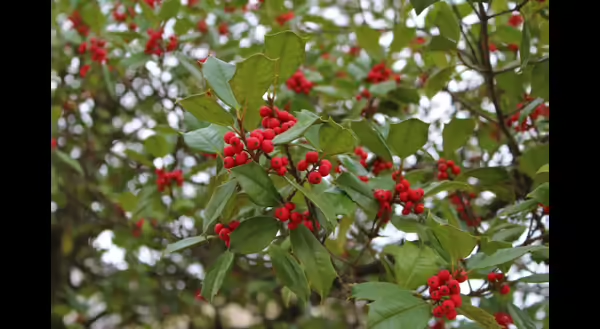
Broad-leafed and evergreen holly species have long been a symbol of Christmas and other winter holidays and traditions. The dark green, prickly foliage combined with contrasting bright red berries can really be a show stopper in the winter landscape providing both ornamental beauty and food for wildlife as berries persist into winter.
In Europe, English holly (Ilex aquifolium) has most often been associated with wintertime holidays. Traditions surrounding holly species began in northern Europe during Roman times among Pagan or polytheistic cultures. Holly was believed to have special significance in the natural world during winter since it remained green during an otherwise colorless time of winter dormancy for deciduous plants. Wintertime holidays often centered on the shortest day of the year, with holly representing the waning sun as the solstice approaches.
Some ancient cultures viewed holly as a protective plant and thought it would bring good luck and safety in the coming year if it was used to adorn their holiday homes. Sprigs of holly or entire branches were used both inside and outside around homes to harness the power of holly for the New Year. The wood of holly was used to construct items believed to have special protective powers or good luck. Perhaps that is why Harry Potter’s wand was constructed from holly wood?
Although no scientific studies to date have shown any correlation between holly and good luck in the New Year, it still remains emblematic of our modern holiday season. Today hollies are prized for their shiny, glossy green leaves and brightly colored, contrasting berries appearing on all sorts of holiday garb. Sprigs of holly are used for wreaths, centerpieces, and other floral arrangements around the holiday season to add a splash of green color.
In the landscape, holly provides that same splash of green during an otherwise drab time of year. I love to see it used in small groupings of 3 to 5 plants interspersed among more deciduous plant material. During the growing season, holly may tend to blend in among the other plants and be less noticeable, although the abruptly spiked leaves are unique and eye-catching.
As other plants senesce, hollies really begin to shine providing much needed greenery in winter which can then become the centerpiece of an otherwise dormant planting bed. When coupled with deciduous plants that provide winter interest, such as exfoliating bark or reddish twigs, hollies can effectively shift the focus of your planting for the winter season.
American holly (Ilex opaca) is a tree-sized plant at maturity creating truly unique evergreen look in the landscape. However, it is only cold hardy to Zone 5, making it somewhat cold sensitive in many parts of central and northern IL. It is a native, but rare tree in Illinois, only occurring in a single southern county. However, its winter-ripening berries are quite popular with birds, providing food for over 20 native species.
A number of varying sized cultivars have been developed for more northern climates, commonly referred to as the Meserve hollies (Ilex x meserveae). Most of these plant remain in shrub size and still offer the spectacular berries, ripening in late fall or winter. They are a great alternative for a smaller space in the landscape although all were derived from hybridizing non-native species.
My favorite native holly is a bit of an odd-ball among the Ilex genus given its deciduous nature. Known as deciduous holly or winterberry (Ilex verticillata), its winter interest lies in the berry display that unfolds as it drops its leaves for the year. With an often spectacular and persistent crop of berries during late fall and winter, you cannot miss a winterberry holly in the landscape. It provides food to over 20 species of native birds as well.
Steeped in holiday tradition, hollies can provide excellent winter interest in the landscape as well as a great source of cuttings for indoor holiday arrangements. These interesting and beautiful plants are diecious, meaning that male and female flowers occur on separate plants. When planning your holly planting take consideration to include both male and female plants to ensure you will have abundant berries during the holiday season and plenty of good luck in the New Year.